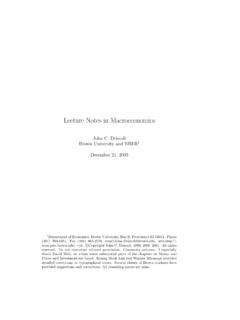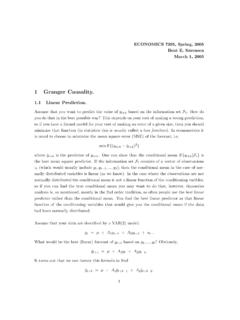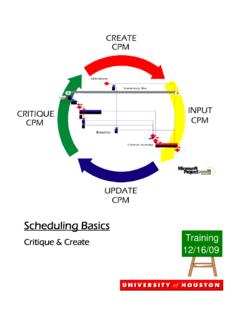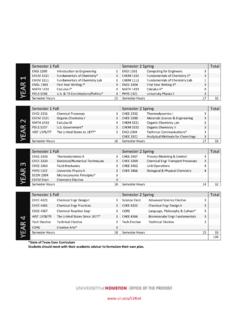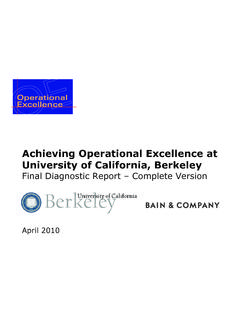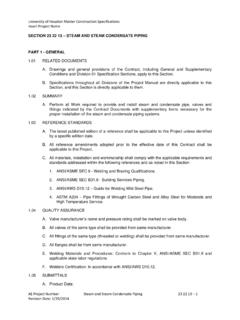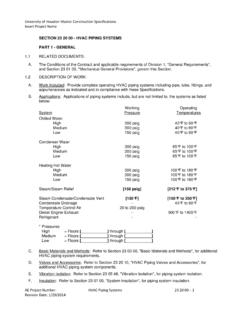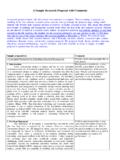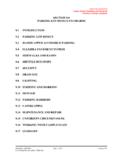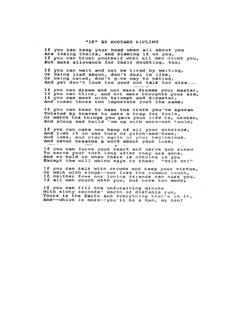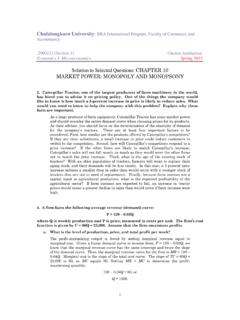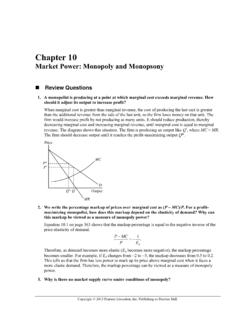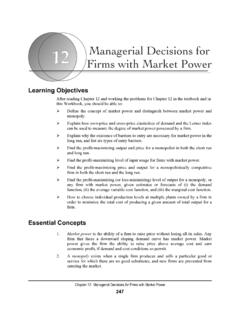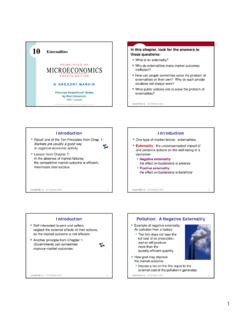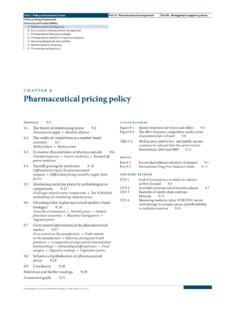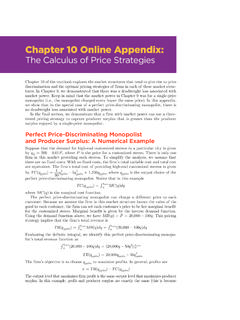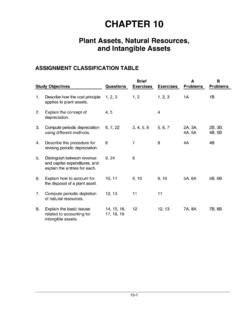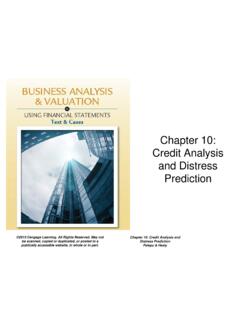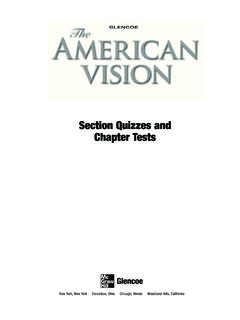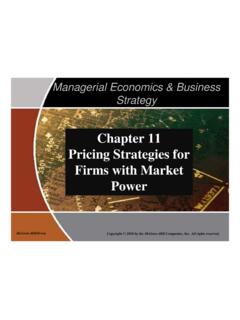Transcription of CHAPTER 10 MARKET POWER: MONOPOLY AND …
1 CHAPTER 10: MARKET power : MONOPOLY and monopsony 120 CHAPTER 10 MARKET power : MONOPOLY AND monopsony EXERCISES 3. A monopolist firm faces a demand with constant elasticity of It has a constant marginal cost of $20 per unit and sets a price to maximize profit. If marginal cost should increase by 25 percent, would the price charged also rise by 25 percent? Yes. The monopolist s pricing rule as a function of the elasticity of demand for its product is: (P-MC)P = - 1Ed or alternatively, P = MC1 + 1Ed In this example Ed = , so 1/Ed = -1/2; price should then be set so that: P = MC12 = 2MC Therefore, if MC rises by 25 percent price, then price will also rise by 25 percent.
2 When MC = $20, P = $40. When MC rises to $20( ) = $25, the price rises to $50, a 25% increase. 4. A firm faces the following average revenue (demand) curve: P = 100 - where Q is weekly production and P is price, measured in cents per unit. The firm s cost function is given by C = 50Q + 30,000. Assuming the firm maximizes profits, a. What is the level of production, price, and total profit per week? The profit-maximizing output is found by setting marginal revenue equal to marginal cost. Given a linear demand curve in inverse form, P = 100 - , we know that the marginal revenue curve will have twice the slope of the demand curve. Thus, the marginal revenue curve for the firm is MR = 100 - Marginal cost is simply the slope of the total cost curve.
3 The slope of TC = 30,000 + 50Q is 50. So MC equals 50. Setting MR = MC to determine the profit-maximizing quantity: 100 - = 50, or Q = 2,500. Substituting the profit-maximizing quantity into the inverse demand function to determine the price: P = 100 - ( )(2,500) = 75 cents. Profit equals total revenue minus total cost: = (75)(2,500) - (30,000 + (50)(2,500)), or = $325 per week. b. If the government decides to levy a tax of 10 cents per unit on this product, what will be the new level of production, price, and profit? CHAPTER 10: MARKET power : MONOPOLY and monopsony 121 Suppose initially that the consumers must pay the tax to the government.
4 Since the total price (including the tax) consumers would be willing to pay remains unchanged, we know that the demand function is P* + T = 100 - , or P* = 100 - - T, where P* is the price received by the suppliers. Because the tax increases the price of each unit, total revenue for the monopolist decreases by TQ, and marginal revenue, the revenue on each additional unit, decreases by T: MR = 100 - - T where T = 10 cents. To determine the profit-maximizing level of output with the tax, equate marginal revenue with marginal cost: 100 - - 10 = 50, or Q = 2,000 units. Substituting Q into the demand function to determine price: P* = 100 - ( )(2,000) - 10 = 70 cents.
5 Profit is total revenue minus total cost: =70()2,000() 50()2,000()+30,000()=10,000cents, or $100 per week. Note: The price facing the consumer after the imposition of the tax is 80 cents. The monopolist receives 70 cents. Therefore, the consumer and the monopolist each pay 5 cents of the tax. If the monopolist had to pay the tax instead of the consumer, we would arrive at the same result. The monopolist s cost function would then be TC = 50Q + 30,000 + TQ = (50 + T)Q + 30,000. The slope of the cost function is (50 + T), so MC = 50 + T. We set this MC to the marginal revenue function from part (a): 100 - = 50 + 10, or Q = 2,000.
6 Thus, it does not matter who sends the tax payment to the government. The burden of the tax is reflected in the price of the good. 5. The following table shows the demand curve facing a monopolist who produces at a constant marginal cost of $10. Price Quantity 27 0 24 2 21 4 18 6 15 8 12 10 9 12 6 14 3 16 0 18 CHAPTER 10: MARKET power : MONOPOLY and monopsony 122a. Calculate the firm s marginal revenue curve. To find the marginal revenue curve, we first derive the inverse demand curve. The intercept of the inverse demand curve on the price axis is 27. The slope of the inverse demand curve is the change in price divided by the change in quantity.
7 For example, a decrease in price from 27 to 24 yields an increase in quantity from 0 to 2. Therefore, the slope is 32 and the demand curve is PQ= The marginal revenue curve corresponding to a linear demand curve is a line with the same intercept as the inverse demand curve and a slope that is twice as steep. Therefore, the marginal revenue curve is MR = 27 - 3Q. b. What are the firm s profit-maximizing output and price? What is its profit? The monopolist s maximizing output occurs where marginal revenue equals marginal cost. Marginal cost is a constant $10. Setting MR equal to MC to determine the profit-maximizing quantity: 27 - 3Q = 10, or Q= To find the profit-maximizing price, substitute this quantity into the demand equation: P=27 () ()=$ Total revenue is price times quantity: TR= () ()=$ The profit of the firm is total revenue minus total cost, and total cost is equal to average cost times the level of output produced.
8 Since marginal cost is constant, average variable cost is equal to marginal cost. Ignoring any fixed costs, total cost is 10Q or , and profit is $ = c. What would the equilibrium price and quantity be in a competitive industry? For a competitive industry, price would equal marginal cost at equilibrium. Setting the expression for price equal to a marginal cost of 10: 27 Q= P=10. Note the increase in the equilibrium quantity compared to the MONOPOLY solution. d. What would the social gain be if this monopolist were forced to produce and price at the competitive equilibrium? Who would gain and lose as a result? The social gain arises from the elimination of deadweight loss.
9 Deadweight loss in this case is equal to the triangle above the constant marginal cost curve, below the demand curve, and between the quantities and , or numerically ( )( )(.5)=$ Consumers gain this deadweight loss plus the monopolist s profit of $ The monopolist s profits are reduced to zero, and the consumer surplus increases by $ 6. A firm has two factories for which costs are given by: Factory #1: C1Q1() = 10Q12 Factory #2: C2Q2() = 20Q22 The firm faces the following demand curve: CHAPTER 10: MARKET power : MONOPOLY and monopsony 123P = 700 - 5Q where Q is total output, Q = Q1 + Q2. a. On a diagram, draw the marginal cost curves for the two factories, the average and marginal revenue curves, and the total marginal cost curve ( , the marginal cost of producing Q = Q1 + Q2).
10 Indicate the profit-maximizing output for each factory, total output, and price. The average revenue curve is the demand curve, P = 700 - 5Q. For a linear demand curve, the marginal revenue curve has the same intercept as the demand curve and a slope that is twice as steep: MR = 700 - 10Q. Next, determine the marginal cost of producing Q. To find the marginal cost of production in Factory 1, take the first derivative of the cost function with respect to Q: dC1Q1()dQ=20Q1. Similarly, the marginal cost in Factory 2 is dC2Q2()dQ=40Q2. Rearranging the marginal cost equations in inverse form and horizontally summing them, we obtain total marginal cost, MCT: QQQMCMCMCT=+=+=12122040340, or MCQT=403.
